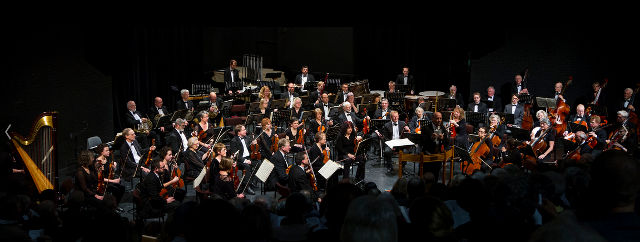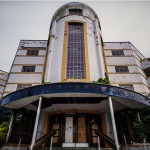Our thanks to Jonathan for his review. In his own words. Ed
Last weekend the Isle of Wight Symphony Orchestra performed at the Medina Theatre again, the second of this season’s concerts. They picked an eclectic programme that required a large number of musicians and some interesting instruments. All four pieces of music were interpretations in music of other art forms, either poems or folk music or artworks seen in an exhibition.
Britten’s Canadian Carnival Overture
The first piece, introduced with characteristic charm and humour by the conductor Jonathan Butcher, was the Canadian Carnival Overture.
Benjamin Britten wrote this in the late 1930s and was inspired by his travels in Canada. It looked to me to be fiendishly difficult to play, with many short phrases played by different parts of the orchestra so the melodies seemed to weave around the stage with a huge variety of sound and lots of energy. It started and ended with a trumpet played off-stage, and included a hoe-down.
‘A Shropshire Lad’
Second in the programme was George Butterworth’s Rhapsody – ‘A Shropshire Lad’. In his introduction Jonathan Butler described a young man of immense promise and talent who was a victim of the First World War.
Butterworth composed a song cycle for 11 of A E Houseman’s poems entitled A Shropshire Lad for singer and piano, but chose the first and last of these to turn into this Rhapsody.
It was beautifully played, and thoughts and emotions flowed through me as I listened. I was enraptured by this rhapsody.
A Song for the Lord Mayor’s Table
The first half of the concert ended with a song cycle by William Walton from the 1960s, – A Song for the Lord Mayor’s Table. This set to music six poems about London, each of which required huge vocal dexterity and range, and were sung with great power and expression by Janet Streeton.
The orchestra followed and accompanied her with sensitivity and precision, smoothly dealing with the many time changes and pauses. Excellent.
‘Pictures at an Exhibition’
After the break the whole orchestra gave a marvellous rendition of Mussorgsky’s ‘Pictures at an Exhibition’. This was written in the 1870s, after his friend the artist Viktor Hartmann died.
The music is a series of reactions to drawings at a posthumous exhibition, interspersed in a rolling theme with variations, intended to give the impression of someone wandering along in an art gallery and noticing various pictures.
This structure gives every element of the orchestra a chance to take the lead, and everyone played their parts magnificently, including a very large saxophone, lots of percussion (Tubular bells!), a harp, an enormous drum, and a small keyboard that sounded like that bit from the Sugar Plum Fairy.
The main theme is very stirring, and no recording could reproduce the thrilling sound of the trumpets with the double basses making everything shake and quiver, and all the strings rushing along at full tilt.
I was amazed to find out that it was originally written as a piano piece and only later expanded for a full orchestra.
An evening of wonders
It was an evening of wonders. I congratulate the IWSO for not taking the easy way, and combining well-known crowd-pleasing works like the Mussorgsky with little-known or downright obscure works that are likely (certainly in my case) to be completely unknown to the audience.
I admire their risk-taking approach.
I took away with me two thoughts. Firstly, how interesting it is that music can reinterpret other media, often producing works that are more famous than the originals, many of which have been lost or destroyed. Secondly, how sad it can be to contemplate what works a talented person might have created had they lived longer.
As usual, I’m looking forward immensely to the next concert, on 22nd March, featuring a Shostakovich symphony and a Haydn Cello concerto.
Image: © Used with permission of Allan Marsh





